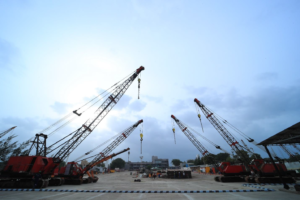- Leading ship recycling company and has been established in 1983
How to Recycle an Old Vessel: Safely and Sustainably
Shipbreaking is an elaborate process comprising several stages and steps. The presence of hazardous substances and lack of safety measures make it difficult to comply with the safety and environmental regulations in the ship recycling industry. We at R.L. Kalthia have compiled a highly informative blog on How to Recycle an Old Vessel – Safely and Sustainably. We have given a comprehensive stance on the journey of end-of-life vessels in a shipyard. You will also learn about different techniques to make ship recycling safer and more sustainable.

Different Steps Involved in Safe and Sustainable Ship Recycling
Ship recycling is an elaborate process involving different stages. The process begins with the contract for ship recycling that shall meet the requirements as per the HKC and/or the EU SRR and its guidelines, the IHM, the ship recycling facility plan (SRFP), SRP, SoC. The ship is then prepared for shipbreaking, and an Inventory of hazardous materials (IHM) is prepared to list all the hazardous materials present onboard.
This is followed by the preparation of a Ship recycling plan (SRP) as per the MEPC.196(62). The SRP shall reflect the specific IHM and provide licensed disposal and recycling solutions for all materials listed in the IHM. After the approval of the SRP, the shipbreaking of the old vessel begins. The ship is dismantled using sustainable practices in a shipyard. After the completion of shipbreaking, a Statement of Completion (SoC) is issued by the relevant authority. Some of the different steps involved in safe and sustainable ship recycling are listed below:
Step 1: Contract for ship recycling
Step 2: Preparation of Inventory of hazardous materials (IHM)
Step 3: Ship recycling plan (SRP) development
Step 4: SRP approval process
Step 5: Approval of SRP by relevant authorities
Step 6: Report and the start of ship recycling
Step 7: Statement of Completion (SoC)
International Regulations and Standards for Sustainable Ship Recycling
To set standards for safe and sustainable ship recycling, many international and national conventions have been launched. The Hong Kong Convention and EU Ship Recycling Regulation are the two major conventions launched to set standards in the ship recycling industry. The EU Ship Recycling Regulation made it mandatory to have an Inventory of Hazardous Materials (IHM) onboard until the end of 2020.
The Hong Kong Convention has been adopted in 15 countries so far, including Norway, Congo, France, Belgium, Panama, Denmark, and Turkey. Both conventions impose responsibilities on ship owners, ship recycling facilities (SRF), and authorities for the safe and sound recycling of ships. The key impact of these international regulations is outlined below:
- Raise awareness through training, workshops, and capacity-building programs
- Foster collaboration with industry stakeholders, government, and civil societies to promote sustainable ship practices.
- Provide technical assistance and financial support to developing countries to improve their ship recycling infrastructure
- Keep a check on shipbreaking activities in the region where environmental and social concerns are prevalent.
Prioritizing Worker’s Safety and Welfare in Ship Recycling
The key steps that are taken to ensure the safety of workers while dealing with hazardous substances on the ship are outlined below:
- Identifying Potential Hazards in Shipbreaking
- Mandating the use of Personal Protective Equipment (PPE) during shipbreaking
- Implement strict safety protocols and procedures at all stages of shipbreaking
- Establish health monitoring systems to address any immediate health concerns
- Implement measures to control and manage environmental risks
- Conduct regular inspections of equipment, machinery, and the work environment to avoid any mishaps and accidents.
Wrapping Up!
The international conventions and emphasized focus on worker safety have transformed the ship recycling industry worldwide. With the combined efforts of international organizations, governments, industry stakeholders, and civil society, old vessels can be recycled safely and sustainably. The shipyards shall be encouraged to strictly follow the rules and regulations laid by various international organizations.